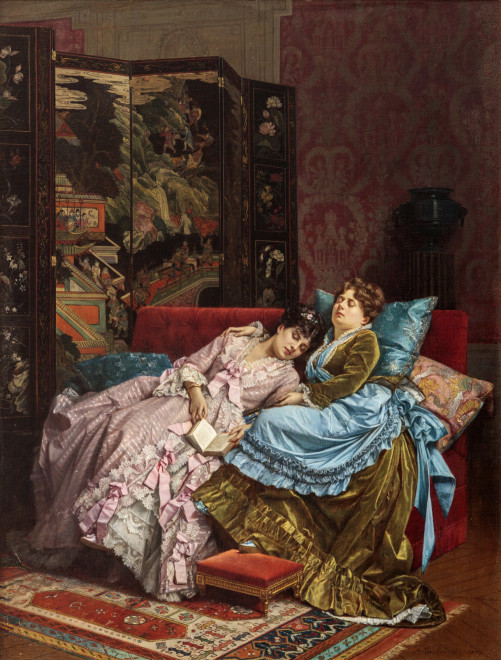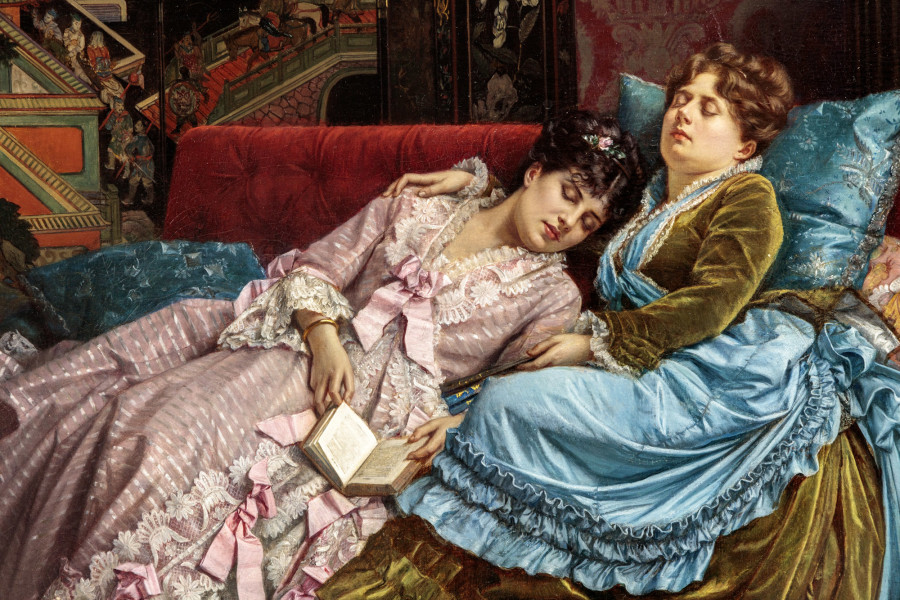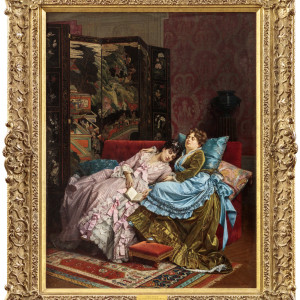Exhibited at the Salon of 1874, A Serious Book immediately drew attention from critics, many who believed it was the epitome of both the artist’s talent and the international market’s hunger for it.
Provenance
Goupil & cie, Paris, March 1874, no. 8843
Alexander Turney Stewart, August 1874 (acquired from the above)
Cornelia M. Stewart, New York (widow of the above and sold, her estate, American Art Association, New York, March 23-25, 1887, lot 39)
John H. Converse, Rosemont, Pennsylvania (acquired at the above sale and sold, his estate, American Art Galleries, January 6, 1911, lot 51)
Mrs. Stetson (acquired at the above sale)
Sale: Christie’s, New York, 19 April 2005, lot 204 as Afternoon Idyll
Acquired by the present owner at the above sale
Exhibited
Paris, Salon, 1874, no. 1721
Literature
“The Salon Paris,” The Athenaeum, no. 2430, May 23, 1874, p. 705
"Le Livre Sérieux," The Illustrated London News, vol. LXV, December 12, 1874, p. 558, illustrated opp.
Edward
Strahan, ed. The Art Treasures of America, Philadelphia, 1879, vol.
I, pp. 39, 52, illustrated opp. p. 46
Kathryn J. Brown, Women Readers in French Paintings 1870-1890, Surrey,
2012, p. 20
Catalogue note
At the age of nineteen, Auguste Toulmouche made his debut at the Paris Salon of 1848. While his first submissions were portraits, the artist soon turned to domestic genre subjects, which were purchased by the likes of Emperor Napoleon III, the Empress Eugénie and other members of the Imperial family. His fame secured in the 1860s, Toulmouche built on his early training in Academic painter Charles Gleyre’s studio, capturing every sumptuous element of the monied classes' changing tastes for fashion and interior design, often adding subtle narratives to further intrigue the viewer. Exhibited at the Salon of 1874, A Serious Book immediately drew attention from critics, many who believed it was the epitome of both the artist’s talent and the international market’s hunger for it. As one writer described, the painting “shows two ladies seated on a couch of red velvet, one of whom has read the other to sleep and then dossed in turn herself. The attitudes tell the tale perfectly. The draperies have been studied with exquisite art, giving the forms within their numerous and voluminous folds to perfection… the dainty but exuberant contours of the torsos… the graceful abandon of the arms, the piquant precision of the coiffures… and the thoroughness of the workmanship are not only perfect in their way,— and that is one which, let it be distinctly understood, neither Raphael nor Rembrandt disdained— but a complete example to painters of M. Toulmouche’s class.” like Carolus-Duran, Jean-Jacques-James Tissot, and Alfred Stevens.[1] Further, A Serious Book evidences Toulmouche’s understanding of his audience’s stylish interests, as he includes a gleaming lacquer screen, a nod to the Belle Epoque vogue for japonisme (an aesthetic influence shared by the artist’s cousin-in-law Claude Monet).
Unsurprisingly, in 1874, A Serious Book was quickly acquired from Toulmouche’s Paris dealer Goupil by the voracious American collector Alexander Turney Stewart (1803-1876), the archetype of the self-made millionaire. Born in Ireland into a working class family, Stewart immigrated to New York at the age of twenty to open a small store selling Irish linen and lace. By 1862, the store took up an entire city block and, buoyed by other successful enterprises, Stewart earned an annual income of nearly $2 million — funding the construction of a fifty-five room mansion at the corner of 5th Avenue and 34th Street. Stewart could buy virtually any masterpiece he desired for his private gallery, and in a relatively short period of time, he acquired many works now held in museum collections. These include Jean Louis Ernest Meissonier’s Friedland, 1807 (circa 1864-75, The Metropolitan Museum of Art, New York) for which he paid a then astonishing $60,000, Rosa Bonheur’s The Horse Fair (1852-55, The Metropolitan Museum of Art) and a several works by William Bouguereau including Homer and his Guide ( Layton Collection, Milwaukee Art Museum) and Return from the Harvest (1878, The Cummer Art Gallery, Jacksonville). Viewing A Serious Book among these impressive compositions, Edward Strahan described it in his Art Treasures of America (1879) as “Toulmouche’s masterpiece… a most painstaking, elaborate piece of fashionable enamel.”[2] Outside of Stewart’s rarified circle of visitors, the composition was also popularly known through its widely distributed print.
A Serious Book was one of two works by Toulmouche in Stewart’s collection which was sold after his widow’s death in 1886. The collection’s renown was acknowledged by the Art Journal on the occasion of its sale (March 1887, American Art Galleries, New York): “The dispersion of the Stewart Collection of pictures in New York brings to an end one of the most famous private galleries of the time. The fact that an American millionaire put it together is significant of a choice stimulated rather than restricted by huge prices, and also significant of a certain modernity of taste and an evident Gallicism.”[3] Other titans of industry and business were eager to emulate Stewart’s connoisseurship and eagerly acquired works from the estate sale to decorate their new mansions with compositions that showed a high level of quality and artistic virtuosity. A Serious Book was bought by John H. Converse (1840-1910), who began his career as an editor for his Vermont hometown’s Burlington Daily and Weekly Times before entering the railroad business, moving to Chicago and later Philadelphia where, in 1873, he became a partner of Burnham Locomotive Works. A noted philanthropist Converse donated much of his fortune and served on many charitable boards including as President of the Fairmount Park Art Association, the nation’s first private, nonprofit organization committed to integrating public art and urban planning. In 1887 at his Rosemont, Pennsylvania home “Chetwynd,” Converse built a gallery described as “enriched by many brushes” in its breadth and diversity, with special lighting used to illuminate day or night works like the newly acquired A Serious Book.[4] While the painting was included among more than sixty others in Converse’s estate sale of 1911, others were gifted during his lifetime—notably Daniel Ridgway Knight's iconic Hailing the Ferry (1888) given in 1891 to the Pennsylvania Academy of Fine Arts, where it remains today.






